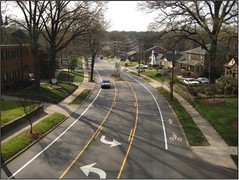
News
By Stefanie Seskin, February 28, 2011
A panel of Complete Streets leaders launched our 2011 Strategy Meeting, graciously hosted by AARP on February 17, and quickly set a high bar for the day. Representing Complete Streets work at the local, regional, and state level, our panel featured:
- Norm Steinman, Planning and Design Division Manager for the City of Charlotte Department of Transportation;
- Chester Jourdan, Executive Director of the Mid-Ohio Regional Planning Commission (MORPC); and
- Ethan Fawley, Transportation Policy Director for Fresh Energy.
Our good friend Jeff Miller, President and CEO of the Alliance for Biking & Walking, led our experts in a stimulating and candid discussion.

Steinman provided important insights into building support for the new transportation paradigm by clearly explaining the policy changes and intended results to elected officials and encouraging public involvement.
Of course, building streets to their new standards has been vital in shoring up long-term support. In the six years Charlotte has been following a Complete Streets approach, they’ve been able to complete great projects all across the city on major thoroughfares and residential streets alike. Each project is like a short story for the City, ones of bad streets turned good with thoughtful, practical policy and design.
These stories have helped build a strong resolve for better streets, so that even as Charlotte faces challenges from the recession, commitment has not faded with staff, Council, or the general public – over 60% of whom recently approved a $157 million bond for transportation projects.
Jourdan shared his experiences as a regional leader, working with numerous municipalities to build a clear, strong vision for the Columbus area. MORPC has long worked on broader issues, like stimulating economic development and creating “lifelong communities,” and had an existing “routine accommodation” policy.
Though this meant moving to a more robust Complete Streets framework was not a sudden shift, he stressed the importance of a transparent and open public engagement process when developing the policy. MORPC continues its outreach during implementation through biannual Complete Streets newsletters and publication of a Complete Streets fact sheet; a planned toolkit will also help communicate how the policy works.

Jourdan feels that MORPC, in its role as the Metropolitan Planning Organization, is able to catalyze new thinking across the region and help communities bridge the funding gap to transform good transportation projects into great ones. Even though political shifts, dwindling transportation resources, and the lack of new federal transportation bill present challenges, MORPC and the greater Columbus area continue to press ahead with Complete Streets: it’s a matter of keeping the region economically competitive, of attracting new residents to build its work force, and of accommodating them in each stage of their life.
As part of his work at Fresh Energy, a non-profit organization focused on energy issues, Fawley coordinates the activities of the Minnesota Complete Streets Coalition. With 65 organizations on board and about 40 individuals spending significant time on last year’s campaign for a Complete Streets law, the Minnesota Complete Streets Coalition is a tremendously effective organization.
Emphasizing the real safety benefits of adopting a policy, the Coalition began working with the Minnesota Transportation of Department early on – a key tactic for not just the law’s eventual passage but also in taking the next steps needed to make Complete Streets a reality in the state. (Fawley shared the story of last year’s campaign on our blog — I highly recommend reading it.)
The Minnesota Coalition continues to foster new new policies in communities across the state, but it now focuses on implementation of the state law and the 15 local policies already adopted. Involving transportation professionals, especially local engineers, and building on their expertise to solve implementation challenges of incorporating Complete Streets into project scoping and repaving operations.
Each of our three panelists, along with the other 55 attendees, agreed that the Complete Streets movement must continue to push ahead, ensuring that the well-earned celebration of policy adoption returns to the tough work of making changes within agencies and in our communities’ streets.
The National Complete Streets Coalition is poised to lead that charge — so stay tuned. We’ll be discussing our next steps and strategy for the next year and beyond in more detail over the next few months.
Related News

© 2025 Smart Growth America. All rights reserved
Site By3Lane Marketing










